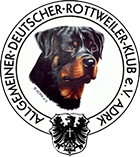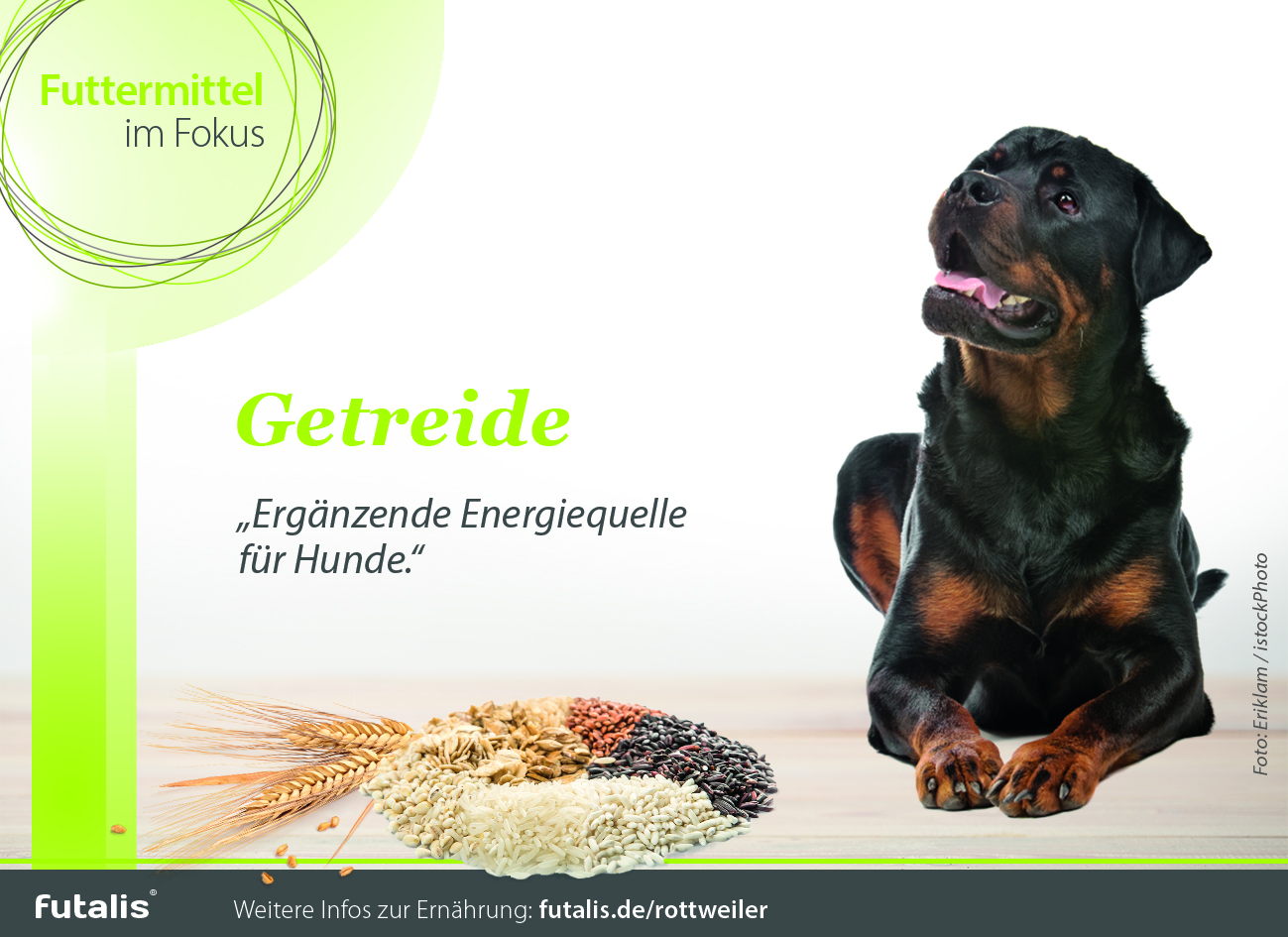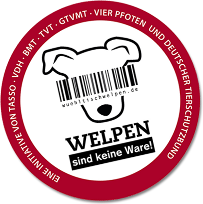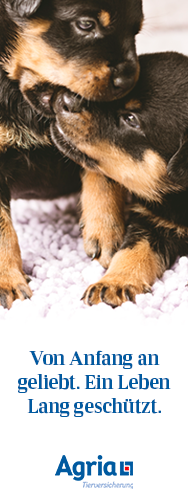| ADRK |
| Allgemeiner Deutscher Rottweiler-Klub e.V. |
Nutritients in focus: grain
Grain is considered a staple food for humans. It also has a high nutritional benefit for dogs. Recently, however, cereals have fallen into disrepute with some dog owners. Read here what cereals are and how they can be used in dog nutrition.
What is grain?
The term grain includes grass-like plants (sweet grasses) that bear fruit in the form of grains. Grains mainly include wheat, spelt, oats, rye, barley, rice, maize and millet. Depending on the type of grain, the grains contain the starch-rich endosperm, the fat- and protein-rich germ and the thin seed husks, which are rich in fiber and minerals, as well as the partially woody husks. Depending on how the grains are prepared, cereal products with different nutrient compositions are produced. The so-called whole grain still contains all the components and nutrients.
Cereal flakes are heated and crushed grains and are therefore rich in starch and protein. Cereal flour consists mainly of starch. Bran consists primarily of the seed husks, which are rich in fiber and minerals. Germ oil is obtained from the fat-rich seedlings. In addition, there are countless other cereal products and by-products that can be used in dog nutrition.
Grain as a source of energy
Due to their high starch content, cereal grains are an ideal source of energy for dogs. Obtaining energy from carbohydrates or starch is very effective and supplements the energy obtained from proteins and fats. It all depends on the type of grain and the way it is prepared. Oat flakes or other cereal flakes are particularly easy to digest, as the starch they contain has already been broken down by heating. Grain products from the human diet, such as pasta or bread, can also be used. However, it should be noted here that other ingredients are added in addition to grain, which the dog also ingests.
Nutrient supply with the grain
Germinated cereal grains and the germ oil obtained from them contain many essential fatty acids and vitamin E. Corn germ oil or wheat germ oil can therefore be a good addition to a dog's diet. A certain amount of minerals and vitamins is contained in whole cereal grains, less so in pure cereal flour. It is therefore beneficial to use flakes in dog nutrition: Cereal flakes are pressed out of the grain using pressure and heat and therefore still contain almost all the original ingredients and nutrients. Unprocessed cereal grains, on the other hand, are less suitable as they are more difficult to digest and can be quite time-consuming for dogs to prepare.
In general, however, the dog's need for many nutrients is covered by animal feed components. A pure nutrient supply via grain or other plant-based products is therefore not easy to achieve and requires an individual ration calculation and special supplementation. In combination with suitable animal products, however, grain is an ideal component of a dog's food ration.
Grains as a source of fiber
Basically, grain is a rather low-fiber feed component, which makes it an ideal source of energy. This applies in particular to cereal products that no longer contain the fiber-rich husks and seed hulls. Slightly larger amounts of fiber are contained in whole grain products, but also in certain husk-rich grain products such as wheat or rice bran. Dietary fiber stimulates bowel movements and can prevent constipation. Ultimately, however, the individual characteristics of a dog determine whether a higher or lower proportion of fiber in the daily diet is advisable.
Concerns about grain
Although grain is one of the basic ingredients in a dog's diet, there are still numerous reports about the supposed unfavorable properties of grain. However, a minority of these are actually substantiated by scientific findings.
Nutrition experts know that the amino acid pattern in grain does not correspond to that of animal proteins. This is why it is not used in food to cover the amino acid requirement, but mainly because of the carbohydrates it contains, which serve as an ideal source of energy. Only a few diseases, such as diabetes mellitus, require a greatly reduced starch content compared to an increased meat content in dog food. The reverse is far more common, particularly in the case of kidney and liver disease. Despite a reduced meat intake, it is possible in these cases to cover the dog's amino acid requirements with a special mixture of feed ingredients.
Grains are often seen as the main cause of allergies. In reality, however, most allergies or intolerances in dogs occur to meat and animal protein sources. Although grain also has a certain allergy potential, this is comparable to other plant-based food ingredients. The sometimes suspected gluten intolerance, which is not an actual allergy, is a human disease and hardly ever occurs in dogs.
Grain is less digestible for dogs in its raw state than after heating. For this reason, grain is never fed to dogs raw, but only after sufficient heating and cooking or processed in dog food. Only then is it guaranteed that the starch is "broken down" and easily digestible. Heated grain with broken down starch, on the other hand, is very well tolerated by most dogs.
Other myths surrounding grain are not scientifically proven and therefore not recognized by nutrition experts. If grain is to be removed from a dog's diet - for whatever reason - it should be replaced by a well-tolerated alternative with a balanced nutrient content.
Alternatives to grain
Dogs that cannot tolerate one type of grain do not usually show adverse reactions to all types of grain. If, for example, a hypersensitivity to wheat occurs, it is perfectly possible to switch to rice. There are also other sources of carbohydrates that are suitable for feeding dogs. These include so-called pseudo-cereals, which are very similar to cereals but do not belong to them in the botanical sense. These include buckwheat, quinoa and amaranth. Potatoes and sweet potatoes, which are vegetables, also provide highly digestible carbohydrates. Other vegetables such as turnips, carrots and Jerusalem artichokes also contain energy-supplying carbohydrates, although their use in dog food is limited due to their higher fiber content.
Why not give up grains or carbohydrates completely?
Conversely, eliminating carbohydrates from a dog's diet would mean that a dog can only get the energy it needs from proteins and fats. However, both are only tolerated to a certain extent and can lead to digestive problems or even put a strain on the metabolism, liver, kidneys and other internal organs if consumed in excess. Supplementing carbohydrate sources - whether grain or an alternative plant-based component - is therefore recommended. As carbohydrates are also only tolerated to a limited extent in the dog's intestines, a balanced ratio of the three energy sources is important. However, no general recommendation can be made here. The individual characteristics of a dog, such as age, activity, nutritional status, but also possible breeding use or existing illnesses, have an influence on the optimum feed composition. A professional and individual ration calculation can provide information on this.










